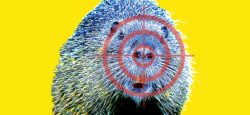Winter 2011
The Nutria Nuisance
70 years ago no nutria existed in Louisiana; now there are several million
Published: February 2, 2015
Last Updated: February 14, 2019
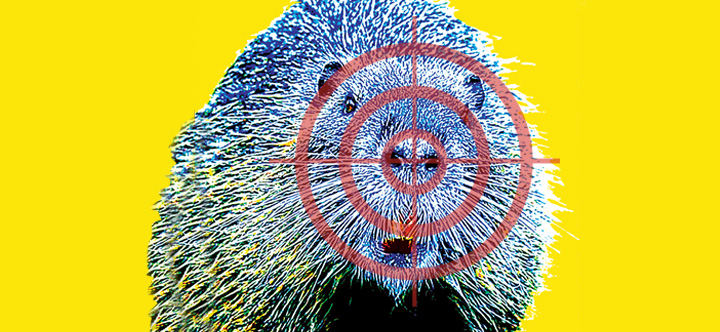
It seems almost an understatement to observe that nutria breed prolifically: 70 years ago no nutria existed in Louisiana; now there are several million. The animals generally mature at age six to eight months, breed year-round, and annually produce about three litters, each containing four to five kits (young nutria). They devour wetland plant life at an alarming rate, denuding the landscape and leaving organic soils exposed to erosion. It is estimated that nutria are presently damaging about 100,000 acres of wetlands in Louisiana. As a result, the animal, once the most profitable fur-bearing species in Louisiana, is now almost universally reviled. The state of Louisiana has classified it as a “nuisance animal,” and for years Jefferson Parish’s SWAT team has used the furry creatures for target practice. “This aggressive, orange-toothed rodent,” complained one outdoor writer, “has degraded the environments it has invaded, threatened native plant and animal species, and thrived despite human attempts to eliminate it.”
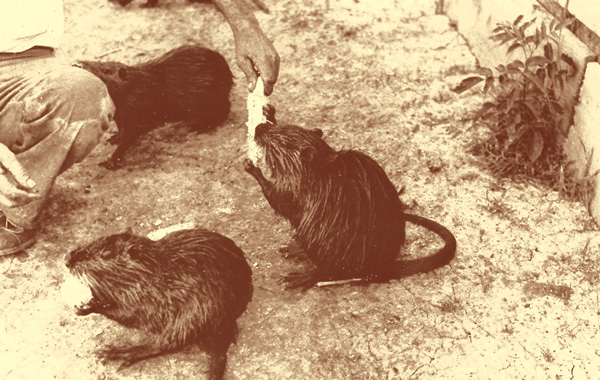
Nutria were kept in pens at the McIlhenny estate when the first shipment of the animals arrived in the late 1930s, purchased from a breeder in St. Bernard Parish. Courtesy E.A. McIlhenny Collection, Avery Island, La.
The person commonly blamed for the state’s nutria invasion (and sometimes for its introduction to the entire North American continent) is Iberia Parish native Edward Avery McIlhenny (1872-1949)—frequently called “M’sieu Ned” by acquaintances—who, among other occupations unrelated to his nutria business, presided over the manufacture of Tabasco brand pepper sauce at Avery Island, La. (His father, Edmund McIlhenny, invented the world-famous condiment.) A typical explanation of his role in bringing the animals to Louisiana maintains:
“Nutria first came to Louisiana from South America in 1937, when E.A. McIlhenny brought 13 of them to Avery Island. … In 1940, some of the nutria escaped during a hurricane and quickly populated coastal marshes, inland swamps and other wetland areas.”
This standard account has been repeated by numerous sources since the mid-20th century. These include regional newspapers like the Baton Rouge Advocate and New Orleans Times-Picayune, as well as national media sources like Audubon, National Geographic, The Washington Post, and NPR’s All Things Considered. The general public has also embraced the story and in doing so has further promulgated it.
This explanation, however, contains errors both of fact and omission on all major points, as revealed by a careful examination of McIlhenny’s private business records in the E.A. McIlhenny Collection at Avery Island. Until now, McIlhenny’s records have remained untapped for information about his involvement in Louisiana’s nutria industry. The actual story is more complex than the popular version of events, and it offers new insight into this important phenomenon in the state’s environmental history.
Although an accomplished businessman, biologist, and folklorist, McIlhenny made no pretense about being a historian. He often embellished stories, particularly about himself, in the jovial manner of a seasoned raconteur. Indeed, it was McIlhenny himself who first claimed to have introduced nutria to Louisiana. As he informed a Houma civic leader in a 1945 letter that subsequently appeared in the Times-Picayune, “I originally brought 15 pairs of the animals from the Argentine … [and] have liberated probably 150 pairs of these animals in Iberia Parish since 1940, and they have spread to the northern limits of Louisiana and the extreme western limits, and have crossed over Vermilion Bay to Marsh Island.”
Although he eagerly took credit for importing nutria to Louisiana, McIlhenny’s private business records tell a different story. His involvement with nutria began tangentially in 1930, when Armand P. Daspit, director of the Louisiana Department of Conservation’s Fur and Wild Life Division, received a bulletin about nutria from Buenos Aires, Argentina. Fascinated by the publication, Daspit consulted McIlhenny, who was widely known as an expert on fur-bearing animals, having for years allowed trappers to harvest muskrat, mink, otter, opossum, raccoon, and skunk on his coastal properties. “I am very much interested in introducing nutria into this country,” wrote Daspit to McIlhenny, “and think that if we could get several pairs and put them [on state property] … at the mouth of the Mississippi River that they would do well.” In reply, McIlhenny advised Daspit:
“Sometime ago I got together quite a lot of data on this subject, and while I believe the animal will do very well if placed on a range that it cannot wander from, such as Marsh Island, I don’t believe that it could be propagated properly elsewhere unless enclosed by a fence, as they are great wanderers. They live on the same sort of food that muskrats thrive on, but the cost per pair is very high.

“I believe should you care to import some of these animals, it would be best to have them enclosed in an area where there is plenty of natural feed, until they develop sufficiently to put them on open range.”
Seventeen years later Daspit recounted in an article for Louisiana Game, Fur, and Fish that McIlhenny, inspired by this inquiry from the Department of Conservation, “promptly procured several pairs and experimented with them on Avery Island. The colony soon grew very large and were liberated in the marshes.” Daspit, however, exaggerated McIlhenny’s enthusiasm for nutria farming, for in actuality it would be eight years after their exchange of letters before McIlhenny purchased his nutria.
In the meantime, at least two other private nutria farms began operation in Louisiana. Susan Brote and her husband, H. Conrad Brote, operated one of these nutria farms in St. Tammany Parish. Interestingly, Mr. Brote served as a captain in the merchant marine, traveling between New Orleans and Buenos Aires, where nutria abounded. (In 2002, after this article first appeared, Times-Picayune reporter Martha Carr observed that Brote “imported 18 nutria from South America in 1933, according to his personal cargo logs, now housed at the Earl K. Long Library at the University of New Orleans.”) In 1945 Mrs. Brote wrote McIlhenny:
“My husband … and I started a nutria farm in Abita Springs in 1933 and had the animals for four years. We raised them very successfully in brick pens but could find no satisfactory market for them. We sold some to fur dealers and other individuals and turned the rest out.”
The release evidently occurred at least several months before McIlhenny purchased his first nutria.
Another nutria farm operated near the community of St. Bernard, in St. Bernard Parish. In March 1938, it was from this Louisiana farm, not Argentina, that McIlhenny obtained his first nutria—20 of them, to be exact (14 adults and six kits), all but two of which were born in the United States. Although McIlhenny’s papers do not record the identity of the farm owner, they do reveal the important role played by A. Bernstein of New Orleans, a raw fur and wool dealer. Bernstein served as middleman in the transaction, advising McIlhenny in early March, “I am able to purchase the nutria for you for the sum of $100.00 and now you will kindly let me know what day you can send your truck to pick them up, as I must let the party know, in order that he may have them ready for shipment.”
McIlhenny replied that he could send his truck anytime, adding “I wish you would tell me how they should be cared for, as I know nothing about the care of these animals, and have never attempted to keep them in captivity”—confirming that he was a novice to the industry, despite the confident advice he had offered Daspit in 1930 about nutria farming. On March 12, McIlhenny posted Bernstein a check for $100, and on March 14 he sent Jim Kennedy, a landscape architect employed in Avery Island’s Jungle Gardens attraction, to retrieve the nutria. Kennedy documented his trip in detail (he even recorded, for instance, an expense of $3.90 on food and gasoline), and on his return he gave McIlhenny a detailed typewritten report of the transaction, which did not go smoothly.
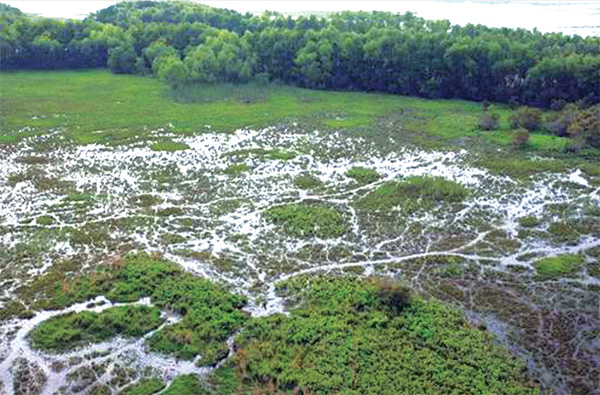
When vegetation is removed from the surface of the marsh, as a result of overgrazing by nutria, the very fragile organic soils are exposed to erosion through tidal action. If damaged areas do not revegetate quickly, they will become open water as tidal scour removes soil and thus lowers elevation. Courtesy Louisiana Department of Wildlife and Fisheries
“The animals were not in New Orleans,” Kennedy recorded, “but at a point near St. Bernard. On arriving at the location it was found that the mother had 6 little ones and the fellow would not let us have them unless we paid the same for them as we did for the fourteen [adults]. An argument issued but was finally settled by Mr. Bernstein paying an additional 2 dollars each for the 6 babies.” Kennedy also relayed Bernstein’s instructions about maintaining the nutria, advising his employer to feed them carrots, beets, cabbage, grass, alfalfa, or “anything green.”
McIlhenny released his 20 nutria into a roughly one-acre pen, but shortly learned how difficult the animals were to contain. In late March a few nutria escaped, all but one of which were recaptured. Twelve days later the sole missing nutria was killed approximately 14 miles west of Avery Island. The incident made a strong impression on McIlhenny, who now surrounded his pen with a bulwark designed to prevent future escapes. “Nutrias have powerful teeth,” he later wrote a potential nutria farmer, “and will cut out of any wood enclosing them, unless the wood is protected on the inside by wire-screen. They will cut the light poultry netting, but will not cut heavy poultry netting. I use 2” mesh netting for protecting the wood on the inside. Unless the pen in which they are enclosed has a floor through which they cannot dig, the enclosure should be sunk at least 2½ ft.—preferably 3 ft.—into the ground. The pen in which I raise nutrias is large … [consisting] of ordinary marsh, with holes dug in it, in which there is a constant supply of water. The fence surrounding the nutria enclosure is sunk three feet into the ground, and extends for four feet above the ground, and is wood with wire covering. The wire covering, however, should not reach the top of the fence, as nutrias climb where they have a mesh in which they can get a foothold. They cannot climb up a plank; nor will they cut through a plank, unless their hind feet are on the ground.”
McIlhenny also learned that the nutria’s prodigious ability to self-replicate was no exaggeration. In less than two years his original twenty nutria had grown to “probably 500 to 1,000 animals”—a population explosion due entirely to natural increase. The situation required the expansion of McIlhenny’s one-acre pen to about 23 acres by early 1939, and to about 35 acres by late 1941. Combined with its voracious appetite, the animals’ prolific breeding taxed McIlhenny’s resources. He made no complaint, however, informing a friend, “They have eaten every spear of grass, and I am cutting the heavy marsh grass with mowing machines and giving them a full truckload every day, besides a little sorghum and corn-on-the-cob. They are thriving wonderfully.”
Once his nutria population had reached a critical mass of about five hundred animals, McIlhenny implemented the next stage of his project: He sold live adults to fur farmers as breeding stock. “I have not marketed any nutria pelts,” he explained, “but am building up quite an extensive stock, and selling a lot of breeding stock to prospective nutria breeders throughout the country.” He was not the only seller of live nutria at the time, however, for biologists at Maryland’s Blackwater National Wildlife Refuge, which is today ravaged by nutria, bought from McIlhenny a “strong breeding male” to pair with females already in their possession. Some of these females, noted the Blackwater scientists, hailed “from as far away as Canada and California.”
While McIlhenny sold nutria to fur farmers across the United States and into Canada, some of his stock found its way into the wilds of South Louisiana. For decades this release has been attributed to “the hurricane of 1940,” which struck the region in early August. McIlhenny, however, never mentioned the escape of nutria during this storm, even though he complained repeatedly about the destruction of his muskrat farm at Avery Island, as well as the loss of muskrat, raccoon, and mink on his 14,000 acres of trapping land at Chênière au Tigre in Vermilion Parish. He did refer to “the loss in rats [muskrats] and other fur-bearing animals” on his Iberia Parish land, but it is unclear if “loss” meant “drowned” or “escaped,” much less if nutria were among these “other fur-bearing animals.”
Ultimately, the alleged accidental escape during the hurricane of 1940 is irrelevant: on June 1, 1940, a little more than two months before the storm, McIlhenny recorded in a memo to himself that he had “liberated” 21 nutria in the marsh on the south side of his “lower shooting pond,” located about a mile northeast of the nutria pen on Avery Island. These freed nutria consisted of seven males and 14 females, “all three-quarters to one-half grown.” McIlhenny referred to this deliberate release in subsequent letters, inflating the number of animals, yet making clear his intention. “You know my activity …” he reminded the state Department of Conservation, “liberating them for the purpose of establishing an addition to our fur industry.”
In mid-February 1941 local trappers reported the capture of three wild nutria on McIlhenny’s property. By the end of the year at least another 41 wild nutria had been taken on his land. As McIlhenny informed a fur dealer in New York, “I have a few skins that were taken by trappers from animals that I liberated in our marshes, and … I would be glad to send them to you, and have you report on the value of the fur. …” McIlhenny elsewhere noted, “I have liberated a good many pair in the marshes here, and am getting good results through the trappers over a radius of twenty miles.”
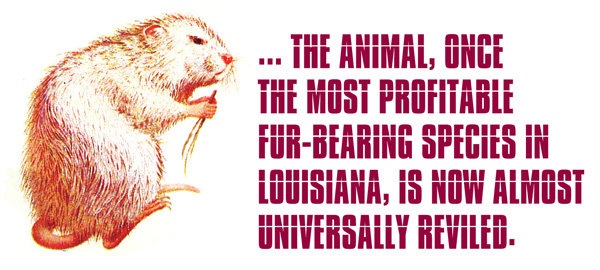 During the next few years McIlhenny continued to sell breeding stock from his Avery Island pen and to share in fur profits from wild nutria trapped on his property. In late 1945, however, McIlhenny made an important revelation: he informed a nutria farmer in Washington state, “I finally let all of my nutrias go in the marshes.” The purpose of this release, which could have involved more than 100 if not several hundred nutria, was the same as that of the smaller 1940 release. “My object in liberating them,” he explained, “is to establish a fur industry on nutria in the waste marshes of Louisiana, and I have succeeded in doing this.”
During the next few years McIlhenny continued to sell breeding stock from his Avery Island pen and to share in fur profits from wild nutria trapped on his property. In late 1945, however, McIlhenny made an important revelation: he informed a nutria farmer in Washington state, “I finally let all of my nutrias go in the marshes.” The purpose of this release, which could have involved more than 100 if not several hundred nutria, was the same as that of the smaller 1940 release. “My object in liberating them,” he explained, “is to establish a fur industry on nutria in the waste marshes of Louisiana, and I have succeeded in doing this.”
Indeed, in 1946 McIlhenny’s trappers nabbed at least 480 of the animals on his Iberia and Vermilion parish lands. Statewide trappers caught at least 8,784 nutria during the 1945-46 trapping season—explaining why the legislature finally imposed a severance tax on nutria pelts (ten cents each), as it already levied on other fur-bearing animals. Nutria trapping increased during the next season to an amazing 18,015 pelts. Fur official Daspit thus praised the animal as a new source of revenue, announcing to the public, “I am firmly convinced that it [nutria] will, in time, equal in value the muskrat production in this state.”
McIlhenny ceased to be active in the nutria industry after December 1946, when he suffered a debilitating stroke. He died in August 1949, and in death would be known to many as the man who introduced nutria to Louisiana—a designation that was no longer an enviable one by the late 1980s and 1990s. Although fur trapping had been a major Louisiana industry since colonial times, demand for nutria fur and other types of fur weakened dramatically in the late 20th century because of several factors. These included a saturation of the global fur market, fashion changes, and the grassroots anti-fur movement. As a result, fur trapping plummeted, and this downturn, combined with several unusually warm winters and the nutria’s reproductive ability, created Louisiana’s present nutria overpopulation.
But how much responsibility does McIlhenny ultimately bear for this infestation? Other possible sources of wild nutria existed, such as the early farms in St. Tammany and St. Bernard parishes, which predated McIlhenny’s own colony at Avery Island. In addition, a nutria farm began operation in Terrebonne Parish in 1947 with 30 animals imported directly from South America. And a year earlier Daspit had informed the Times-Picayune that, just as he had originally proposed in 1930, “the state’s latest fur-bearing animal, the nutria, will be turned loose in the Pass L’Outre [sic] region at the mouth of the Mississippi river,” where the state maintained a 66,000-acre wildlife refuge in lower Plaquemines Parish.
Clearly the proliferation of nutria in Louisiana is much more complex than previously believed, and the subject warrants additional research in the archival papers of the state Department of Conservation, the Department of Wildlife and Fisheries, and particularly in the papers of state fur official Armand P. Daspit. Regardless, the E.A. McIlhenny Collection at Avery Island indicates that while McIlhenny purposely released a small number of nutria in 1940 and a substantially larger number by late 1945, he was neither the first nor even the second nutria farmer in Louisiana; nor was he the first in the state to set loose the animals intentionally; nor did he import them from Argentina—all claims that were previously accepted as indisputable and, like nutria themselves, proliferated wildly.
———
Shane K. Bernard is historian and curator of the McIlhenny Company Archives at Avery Island, Lousiana. He is the author of several books, including Swamp Pop: Cajun and Creole Rhythm and Blues (1996), The Cajuns: Americanization of a People (2003), Tabasco: An Illustrated History (2007), and Cajuns and Their Acadian Ancestors: A Young Reader’s History (2008). This article previously appeared in Louisiana History, a publication of the Louisiana Historical Association.
